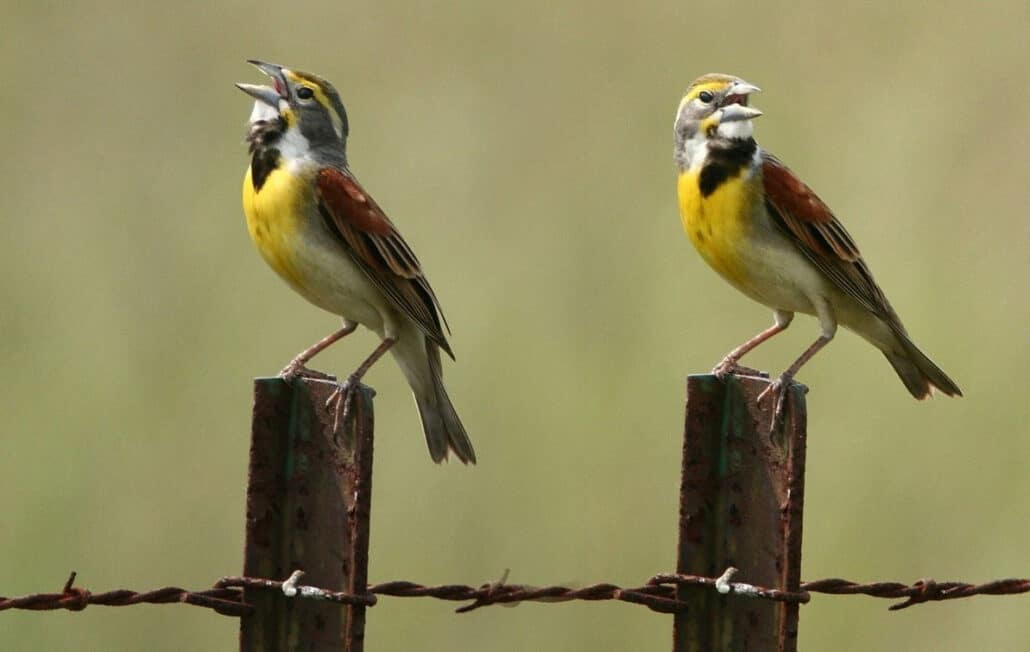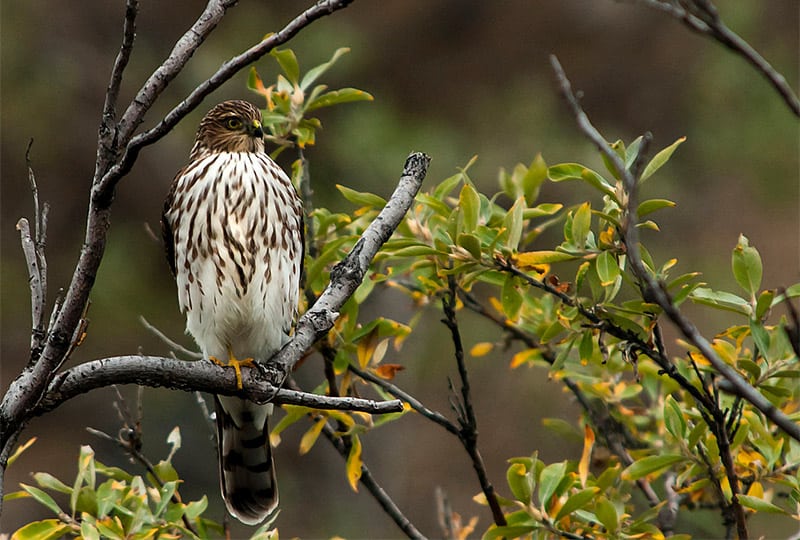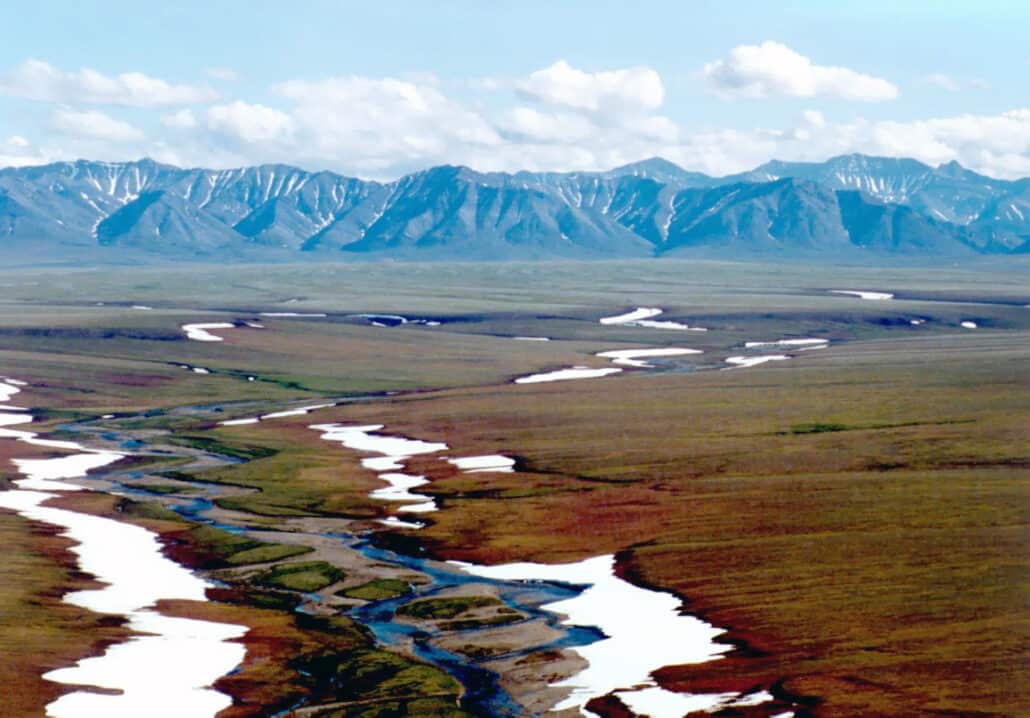1. American White Pelican
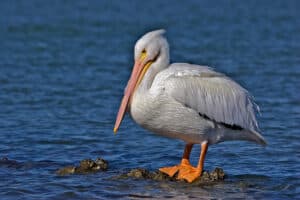
High above a reservoir, a flock of enormous birds circles gracefully in the sky, majestic as white clouds on an autumn day. These are American white pelicans, the biggest birds in Iowa, weighing 20 pounds each, with a nine-foot wingspan. They are pure white except for black flight feathers on their wings. American white pelicans use the pouches of their huge bills to scoop up fish. Unlike the closely related brown pelicans, which dive beak-first into the water after their prey, white pelicans fish while swimming on the surface. By day they locate their prey visually, but at night they delicately dip their bills into the water and detect the fish by feel.
Look for American white pelicans in April and then again from mid-August through September, while they’re migrating through Iowa to or from Canada or Minnesota, where they nest. They have always migrated through Iowa, but until the late 1980s they were usually seen only in the western counties. Recently they’ve expanded eastward.
Good places to find pelicans are at the four big reservoirs: Coralville, Red Rock, Rathbun, and Saylorville. At Jester Park, on the west shore of Saylorville Reservoir, crowds of human admirers flock to the area to see more than 10,000 pelicans at the annual Pelican Festival, the weekend following Labor Day. The event is co-sponsored by the Des Moines Audubon Society, the Iowa DNR, and the U.S. Army Corps of Engineers. For more information about Pelican Festival activities, call 515-323-5300.
2. Snow Goose

Distant gabbling sounds make you look up, into the cold sky of early spring. There, above the not-yet-green fields, a wavering line of white birds races northward. Snow geese are on the move, heading for the Arctic, to breed in northern Alaska, Greenland, or Siberia. Hundreds of thousands pass through Iowa in spring and fall. If you encounter them along the Missouri River Valley flyway at a wetland such as De Soto National Wildlife Refuge in Harrison County or the Riverton Area in Fremont County, you may experience seeing them all rise into the air at once in a blizzard of wings and a thrilling cacophony of calls.
Snow geese come in two forms, white and blue. Blue snow geese look so different from the whites that for a long time they were mistakenly considered a separate species. However, a mated pair may consist of a blue and a white, and a single brood of baby geese can include both blue and white goslings. White snow geese vastly outnumber blues, making it an interesting birding exercise to look for the blue geese in a flock.
Eating a vegetarian diet, snow geese live in dense colonies. Large flocks feed together on the leaves, seeds, and roots of grasses. Indeed, some biologists are concerned that snow geese have been so successful, their population increasing so radically, that they may be overusing and destroying the very vegetation they and other species depend on in their Arctic breeding habitat.
3. Northern Shoveler
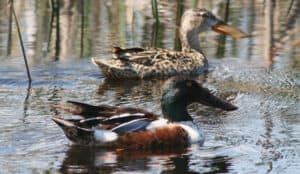
A reservoir or farm pond may suddenly be covered with ducks in early spring, when waterfowl migration is in swing. A flock that arrives at night may rest and replenish themselves for a few hours or more before resuming their migration. And one of Iowa’s most entertaining migrant ducks is the northern shoveler, whose long, shovel-shaped bill has earned it nicknames in the past such as broadbill, souplips, and mule duck. It’s easy to identify its profile in flight, because the shoveler’s bill is noticeably longer than its head.
The shoveler’s odd bill is highly specialized for filter feeding. The duck swims with its chin in the water and its bill out flat in front and partly submerged. If the water is muddy, that’s fine with the shoveler. It likes what it finds in muddy water. Moving its head side to side, the shoveler sluices the water for tiny edible items, which it strains out with comb-like structures along the margins of its bill. Shovelers eat aquatic insects such as dragonfly larvae, small fish, crustaceans, seeds, grass, algae, and duckweed.
Though shovelers are plentiful during spring and fall migration, most of them leave Iowa to breed in the Great Lakes region. A few spend the summer in Iowa, with a small number breeding, mostly in the north central. Nesting pairs are sometimes found in wetlands such as Union Slough National Wildlife Refuge in Kossuth County and Welch Lake in Dickinson County.
4. Northern Bobwhite

Walking in the southern Iowa countryside, you see something moving in the brush by the edge of a field. You stop and study the fenceline. There’s a bobwhite watching you, plump and rounded like a miniature chicken. Its white throat and eyebrow, contrasting dramatically with the dark top of its head and dark eyeline, reveal that it’s a male. You don’t have a long time to study the intricate patterns of the bird’s face and sides, because the little bird is already ducking into the weeds. And now you realize that he’s not alone. You glimpse the flurry of a dozen bobwhites scattering and running for cover along the fence.
Although bobwhites are fairly common in southern Iowa (and uncommon in the north), you’re unlikely to see them unless you’re watching for them. They spend most of their time on the ground, where their earthy colors blend into the surroundings. However, in spring the male’s whistled call, bob-white! with the accent on the second syllable, will put you on alert that they are in the vicinity.
Several species of quail inhabit western North America, but bobwhites are the only quail found in Iowa. Their other relatives are turkey, grouse, and pheasants. Bobwhites need a diverse landscape that includes grassland, brush, crops, and open woods. Although food is plentiful in the farming environment of Iowa, bobwhite numbers have been on the decline for many years, probably due to clearing their varied habitat for row crops, to agri-chemicals, and to excessive hunting.
5. Short-eared Owl

You’re driving on a gravel road in rural Iowa at dusk. Snow lightly covers the open ground. A crow-sized, round-headed bird flies low back and forth over an uncut field. It flaps buoyantly, like a butterfly—lazy, almost floppy. You’ve discovered a short-eared owl, hunting for voles and mice.
If it has white underparts, it’s a male. Female have buffy bellies. Both genders have dark stripes on the upper breast. Toward the end of each long, narrow wing, on the upper side, is a large buffy patch, the color of a candle flame. (The owl’s scientific species name, flammeus, means “like a flame.”) The owl may land on a fence post, and then, especially if it’s alarmed, you may notice two small bumps close together on its head. These look like ears, and they give the owl its name, but they’re really just feather tufts.
Short-eared owls nest on the ground in open places, in prairies, marshes, and tundra. They once bred throughout the grasslands of Iowa, but when the native prairie was lost, short-eared owls vanished as a nesting species in the state. A few visit Iowa in winter. A small group of two to eight may remain in the same location all winter, hunting together over grassy, weedy fields. They sometimes communicate with soft, chirpy barks.
6. Cliff Swallow
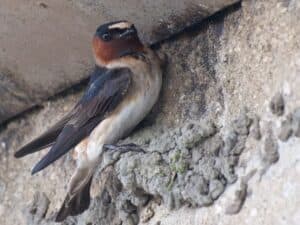
Cliff swallow nests look like rows of earthen jugs squashed up against the side of a bridge, wall, or cliff. In spring the birds congregate at mud puddles, rolling up daubs of clay in their beaks and carrying them to the nesting colony. Billful by billful, a pair builds up a globular structure that will be nursery to their young. Sometimes on nests in progress you can see lighter, partly dry clay from previous days’ efforts, with damp, darker clay revealing more recent work.
Crossing an Iowa river in spring or summer, keep an eye out for flocks of small birds diving toward the bridge and pouring up from under it. If you stop and look at the sides of the bridge, you’ll see the nests, inaccessible to predators and sheltered by an overhang. As the young birds approach the age when they will fledge (leave the nest) their faces appear in the nests’ doorways, waiting for their parents to deliver food. High above the river or ravine, there is no stepping out of the nest onto a branch for fledgling cliff swallows, no practice flapping. This bird has only one way to graduate from the nest—directly into full flight.
Cliff swallows have short, square tails, dark throats and white bellies. Adults have white foreheads. Cliff swallow colonies have increased over the last few decades in Iowa. They’re found throughout the state in summer, though they’re more abundant in northern and eastern counties.
7. Black-and-white Warbler
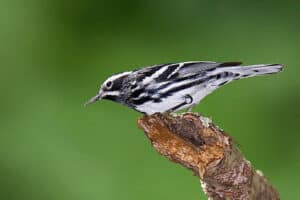
A tiny bird creeping along the larger branches of a tree like a nuthatch may turn out to be a black-and-white warbler. It gets much of its food from crevices in the bark, where beetles, aphids, and other insects hide. Since it doesn’t depend entirely on insects that feed on developing foliage, the black-and-white can penetrate northward earlier than other warblers. And since, unlike many warblers, it’s often out in the open, it’s easy to spot. You may be alerted to its presence by its simple, high-pitched song, which sounds like weezy, weezy, weezy.
Although it isn’t as colorful as some warblers, the black-and-white warbler is striking, its stripes as sharply defined as a zebra’s. It has a white central stripe on top of the head and black-and-white stripes on face, back, and sides. You can tell the adult male, with his black throat, from the female, whose throat is pale or white.
The bird spends only a short time in Iowa. The first migrants arrive about the first of May, ahead of the main warbler migration, and are gone within three weeks. In the fall, they are in Iowa from the middle of August until the third week of September. Oddly, although the black-and-whites nest only rarely in Iowa, it breeds regularly in states on all sides—Missouri, Illinois, Wisconsin, Minnesota, South Dakota, and Nebraska. Some birders call it the phantom of Iowa’s summers, arguing that it ought to nest in the state.
8. Yellow-throated Warbler
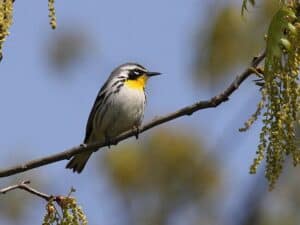
Look for it early in spring, before the leaf buds have opened. Listen for its clear musical song, starting high and dropping lower note by note. There! A flash of sunshine yellow attracts your eye to a tiny bird moving high among the branches of bare sycamore trees. The yellow throat and intricate black-and-white facial pattern tell you that you’ve found the yellow-throated warbler.
The yellow-throated warbler is one of Iowa’s most sought-after warblers. It arrives in the state earlier than most warblers, usually during the second week of April. If you seek it two weeks earlier, you won’t find it, because it will still be traveling from its wintering ground in Central America. Search for it two weeks later, and the birds will be much harder to see in the burgeoning foliage, and photographing them will be almost impossible.
Iowa forms the northern boundary of the yellow-throated warbler’s range, which is primarily in states south and east. Unlike most warblers, which are only passing through on their way to their nesting grounds farther north, the yellow-throated remains and breeds in Iowa.
It’s found at scattered locations throughout Iowa, especially in the southeast part of the state. A reliable location is among the sycamores at the Ely Ford picnic area at Lacey-Keosauqua State Park, in Van Buren County, where for a few days in early April it’s the most conspicuous bird around. It’s also frequently found at Ledges State Park, in Boone County.
9. Dickcissel
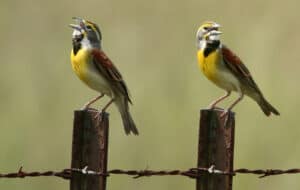
Suddenly on a May morning, sizzling songs erupt from grasslands and roadsides. Just in from their long journey north, male dickcissels announce themselves by name. Dick, Dick, Dick, sz sz sizzle, they sing from grass stems, fenceposts, and wires. Dickcissels are sparrow sized, with thick, conical bills, suitable for cracking seeds. The male’s yellow breast is set off by a black V on his throat, and he has rusty wing patches that are conspicuous in flight. The female is plainer and lacks the black V accent.
Although dickcissels have grown scarcer elsewhere in the Midwest, they appear to be doing fairly well in Iowa. This is probably because the CRP (Conservation Reserve Program), which motivates farmers to keep some land in grass rather than crops, maintains habitat suitable to these prairie birds. Males are polygynous, each attracting as many mates as the territory he holds can support. The females construct bulky, cup-shaped nest nests, hiding them close to the ground in grassy or weedy fields or in alfalfa.
Abundant throughout rural Iowa in early summer, dickcissels start getting harder to find after the first of August. By the end of September they’re gone from the state. In migration, these birds travel in flocks of hundreds of birds. On their wintering grounds, especially in Venezuela, where they are concentrated in huge flocks, they are vulnerable to control measures such as mass poisonings. The long-term survival of this characteristic Midwestern bird is a challenge that crosses international borders.
10. Bobolink

Prairie landscape perfectly suited the bobolink, with tall, dense grasses to hide a nest located in a hollow on the ground, and with plenty of seeds to eat, from a wide variety of plants. There weren’t many trees in the prairie, but male bobolinks managed to make themselves conspicuous to rivals and potential mates, singing their tinkling, bubbling song while hovering above the grasses. When Iowa’s prairie was converted to cropland, eliminating their preferred habitat, bobolinks began nesting in hayfields, which seem similar to prairie. However, hayfields are often mowed in June, while bobolinks are still nesting. Inevitably, bobolink populations have crashed.
Bobolinks do still nest in Iowa, though in reduced numbers. One joy of spring is discovering a grassy pasture with half a dozen or a dozen bobolinks perched on fences or chasing one another just above the vegetation. The males are strikingly patterned, with purely black bellies, black-and-white wings, and a yellowish patch on the back of the head. If it weren’t for the males to catch your attention, you might not notice the females, with their drabber, tan-and-brown stripes.
Bobolinks spend only two or three months in Iowa, arriving in early May and departing in July. By the time they leave, the males have molted out of their flashy breeding plumage and look like the females. Few birds travel as far as bobolinks on migration. After wintering in Argentina, bobolinks fly as much as 14,000 miles round trip to nest in northern North America.

